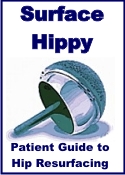Oxford Partial Knee Replacement
By Dr. Bernabe at the Advanced Orthopedics CA
Regarding the Oxford knee. This is a wonderful surgery. Most patients who
undergo total knee replacement do not need a whole knee replaced. Most of these
patients only have arthritis on the medial side, and yet they get the full monty:
8-12 inch incision, 5-7 day hospital stay, 3-6 month rehab, tons and tons of
pain post-op, and worst of all, tremendous bone loss from cutting most of the
femur, tibia, and patella. Trust me, I know. I used to be one of these surgeons.
I can't tell you how many times I opened up a patient's knee, and see that they
are bone-on-bone only on the medial side, but the patella and lateral side are
clean as a whistle. I always cringed and felt guilty about taking the saw and
cutting out all those good parts that once gone, are gone forever.


Here comes the Oxford knee. Fix the involved side, leave the other parts alone
so the patient can still enjoy them for many many years to come. The result? I
consistently perform Oxfords now with a 3 INCH incision, overnight stay at the
hospital (hoping to do them outpatient someday), and 3-6 WEEK rehab with hardly
any post op pain. My patients are very happy.
All joint replacements, whether partial or total, will eventually fail. Some
will fail in 10, some in 15, some in 20 years or beyond. But when a TKR fails,
the patient now has to undergone a nasty total joint revision surgery. When the
Oxford knee fails, you just take it out, then do a primary total knee, not a
revision surgery.
If knee pain is affecting your lifestyle, then you need to know this: the new concept in joint replacement surgery is to only replace the worn out portion of the arthritic joint.


The Oxford Partial Knee Replacement is the first implant that can accomplish
this task with proven long-term results of 98% at 10 years and beyond. For this
reason the Oxford makes a whole or total knee joint replacement NOT necessary
in many cases.
The Oxford Unicompartmental Knee System offers these advantages:
Many orthopedic surgeons today still do not recommend partial knee
replacement for their patients because they are not familiar with the Oxford or
qualified to do it. If your orthopedic surgeon tells you "partial knee
replacement does not work", you need to get a second opinion! If your orthopedic
surgeon tells you a different brand of partial knee replacement has the same 20
year success rate as the Oxford, ask him to show you the scientific paper or
data supporting this opinion.
To be qualified to implant an Oxford, the FDA requires an orthopedic surgeon to
complete an advanced training course. This training is required because the
implantation technique for this procedure is very precise and the operation must
be done correctly
COMMON MYTHS ABOUT PARTIAL KNEE REPLACEMENT:
1. "Partial knee replacements do not work!"
2. "Why have a partial knee now when you are going to need a total knee in the
future?"
3. "You don't need an Oxford. All partial knee replacements are the same!"
The Oxford knee is the ONLY partial knee system with a proven track record of
92% success rate at 20 years. The Oxford knee has also been shown to slow down
the progress of arthritis in the other parts of the knee. Why cut out the
perfectly good parts of the knee when only the bone-on-bone medial side needs to
be replaced? The other partial knee replacements systems do not have the same
worldwide proven acceptance as the Oxford Unicompartmental Knee.
Visit the Arthritis Foundation to see a graphic animation presentation of how a Partial Knee Replacement is performed. (This is in cartoon form, not real surgery)




